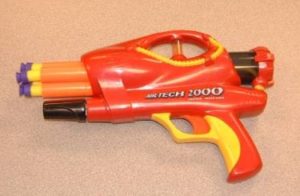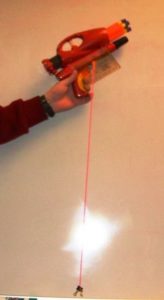Model Description
This is a simple demonstration of the basic principles and behavior underlying projectile motion. A Nerf gun is used to show that projectile motion can be modeled by a particle having a vertical component of motion with constant acceleration, and a horizontal component with constant velocity (zero acceleration). This demonstration should take 5-8 minutes.
Engineering Principle
A projectile follows a curved path that is approximately parabolic, provided that air resistance can be neglected. This curvilinear motion is planar (approximating a portion of an inverted parabola in a vertical plane), and describable in terms of horizontal (x) and vertical (y) coordinates. The motion of the projectile can be modeled by a particle having a vertical component with constant acceleration (g, downward) and a horizontal component with constant velocity (zero acceleration). The following equations describe the particle’s motion in terms of these coordinates:

Notice that the two equations are independent—the horizontal and the vertical components of the particle’s motion can be considered separately. If air resistance were not negligible, however, such as for a paper wad, the equations would be coupled—and more complicated.
What You Need
| Item | Quantity | Description/Clarification |
|---|---|---|
| Nerf Gun | 1 | Any model works as long as it contains soft, nerf-like projectiles, to which a linear impulse is applied by a compressed spring. |
| Protractor | 1 | The protractor is used to measure the angle of the toy gun’s inclination when the soft projectile is fired. |
| Yard Stick | 1 | You can make a plum bob out of a string and a small weight like a nut. It is used in conjunction with the protractor to determine the gun’s angle with respect to the horizontal plane. |
| Tape Measure | 1 | The tape measure is used to measure the horizontal distance from the launch point to the impact point. |
| Stop Watch | 1 | The stopwatch is used to measure the projectile time-of-flight. |
How It’s Done
Before Class: Mount the protractor to the toy gun so that the flat edge is aligned with the barrel and the curved edge faces down. Attach the “plumb bob” to the middle of the protractor’s flat edge, to permit angular measurements of the barrel’s inclination angle. Make these attachments in such a way that the operation of the toy is not hampered. Experiment with the toy gun so that you have a feel for how far and how high the soft projectile will go within the classroom.

In Class: Introduce the equations above and use the toy gun to validate them. Use students as time keeper, recorder, impact point marker, etc.
Ask students to predict which will hit the ground first, a soft projectile fired by the toy gun, or a projectile dropped from the firing height at the same time. Demonstrate that regardless of the firing height, both projectiles impact the ground at the same time as long as the barrel is horizontal. This shows that the vertical and horizontal components are independent.
Determine horizontal and vertical launch velocities from measurements of angle of inclination, launch height, and time of flight using the equations above.
Demonstrate, space permitting, that different angles of fire can result in the same range. (This may be difficult if your class has a low ceiling.)
Observations: The students should observe that a projectile dropped from some height h impacts the ground at the same time as one that is fired horizontally by a toy gun from the same height. The students should also observe that there are generally two angles of fire which result in the same impact point—the only exception is the 45o firing angle, which only has one.
Additional Application: Once the firing velocity is determined, the students can determine the firing angle and height required to hit some target of interest, say the mascot of the school’s arch rival on the sport field!
